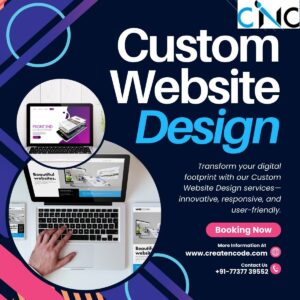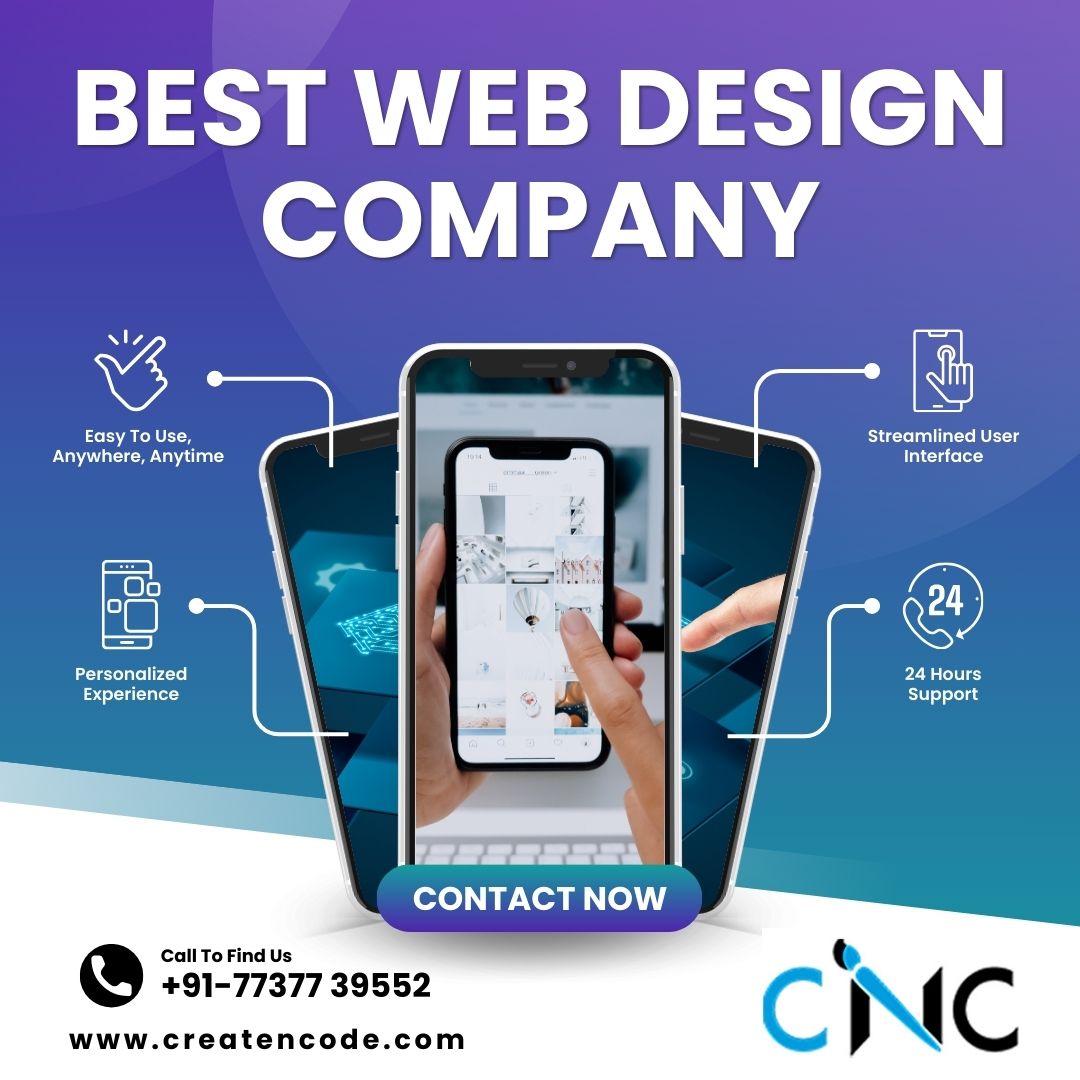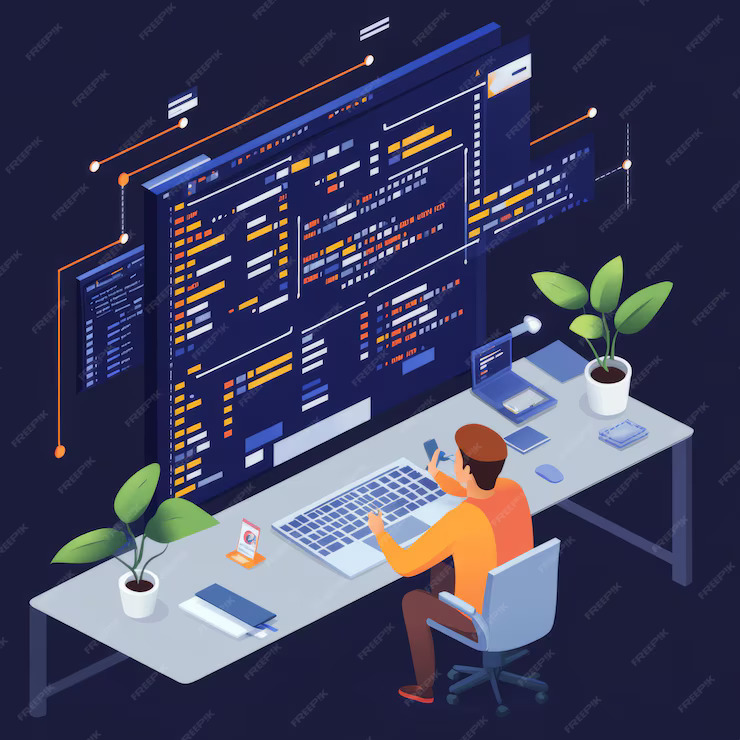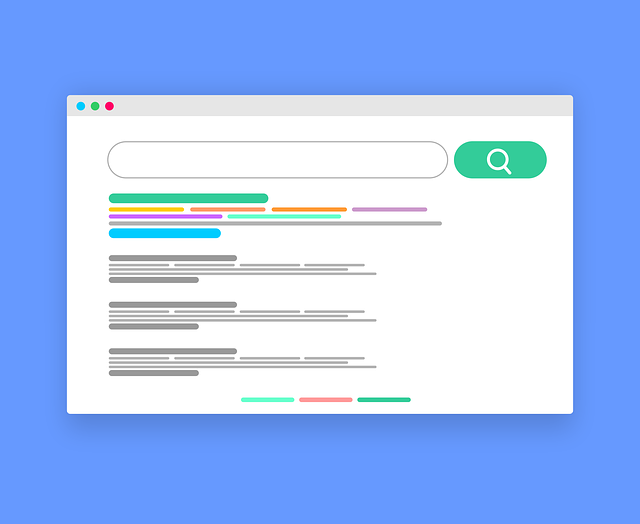A well-designed website is a business's digital shop, therefore it's critical to develop a user experience that is both fun and easy to use. Website design influences visitors' perceptions of a brand as well as their interactions with it. Important factors that make web design crucial are as follows:
Initial Thoughts: A website that is visually appealing makes a good first impression and entices users to explore more. UX, or user experience A well-designed interface facilitates navigation, making it simpler for users to locate information and carry out required tasks.
Brand Recognition: A strong brand identification and awareness are established with the use of consistent branding elements, such as color schemes and typography.
Conversion Rates: Having well-designed calls-to-action and efficient checkout procedures can result in increased conversion rates.
Search Engine Optimization (SEO): A well-structured website is more likely to rank higher in search engine results, driving organic traffic.
Responsive design is crucial because mobile devices are being used for surfing more and more. A website that is responsive adjusts to different screen sizes so that users on PCs, tablets, and smartphones have a flawless experience. Thanks to Google giving preference to mobile-friendly websites, this not only improves user experience but also boosts search engine ranks.
Simple Menu Structure: Content that is arranged into categories that are simple to find makes it easier for users to find what they're looking for quickly.
Breadcrumbs: These helpful navigation tools let visitors know where they are in the site structure, which makes it simpler for them to go back and find more information.
Search Functionality: Users may find certain products or information fast thanks to a prominent search bar.
Font Size and Weight: To assist distinguish material, use bolder, larger fonts for headings and lighter, smaller fonts for body text.
Color Contrast: Highlighting important information and ensuring readability are achieved by using contrasting colors for the background and text.
Whitespace: Sufficient distances between components reduce clutter and improve the design's overall appeal.
Expert Photographers: Purchasing high-quality product photography can greatly raise the perceived value of a product.
Image Enhancement: Compressing images to reduce loading times while maintaining quality is essential for performance.

Functionality: What Is It? The technological features of a website that allow it to carry out operations and offer a seamless user experience are referred to as functionality. This covers forms, interactive features, loading times, navigation, and general usability.
What does aesthetics entail? A website's layout, color scheme, typography, graphics, and overall visual appeal all fall under the category of aesthetics. Users are engaged and the brand's identity and values are reflected in a well-designed appearance.
Researching the Market To gain insight into customer preferences, competition websites, and industry trends, market research is essential before beginning any web development project. By understanding what functions best in the corporate sector, this research aids in website customization.
Establishing Goals The goals of the website must be stated clearly. The design and development process is guided by a defined objective, whether that mission is to promote items and services, provide information, or create leads.
Development of User Personas Understanding the needs, tastes, and behaviors of the target audience is facilitated by the creation of thorough user personas. This data is essential for creating a website that appeals to its target audience visually and functionally.
Navigating With Intuition Users should be able to locate information quickly and easily with the help of straightforward, intuitive navigation. Users can explore the website with ease if it has a well-organized menu, breadcrumbs, and labels that are easy to understand.
Designing User Experience (UX) By concentrating on UX design, a website may be made to function smoothly and be entertaining to use. This includes responsive design for mobile devices, quick form loads, and engaging interactive features.
Availability It is essential to make sure the website is usable by everyone, including people with disabilities. This is adhering to web accessibility guidelines, which include adopting accessible fonts, enabling keyboard navigation, and supplying alt text for images.
Continual Branding Retaining uniform branding throughout the website serves to strengthen the company's identity. This entails utilizing the brand, color scheme, font, and graphics of the business consistently across the website.
Diagrammatic Hierarchy By using visual hierarchy, you may direct users' attention to the most crucial parts of the page. Element location, color, contrast, and size, such as for headlines, buttons, and images, can help achieve this.
Superior Pictures and Illustrations Utilizing photos and graphics of the highest caliber improves the website's aesthetic appeal. Photos ought to be optimized for quick loading times and pertinent to the content.
CTAs, or call-to-actions Desired actions, such subscribing to a newsletter or getting in touch with the business, are guided by well-designed call to action (CTAs). They should make the following step obvious and stand out visually.
Engaging Elements Including interactive elements such as forms, sliders, and movies helps improve user interaction. Usability should not be sacrificed in order for these components to be smoothly included into the design.
Testing for Usability Real users are used to test usability, which helps find possible problems and areas that need work. This may entail user input, A/B testing, and analytics tool analysis of user activity.
Constant Enhancement The process of developing a website never ends. Maintaining the website's functionality and aesthetic appeal requires regular performance monitoring, user feedback, and update implementation.
Systems for managing content (CMS) Without requiring a great deal of technical expertise, people can develop, manage, and publish content on online portals using platforms called content management systems (CMS). Among the widely used CMS systems for web portal construction are:
WordPress
Popular for its versatility, ease of use, and large plugin ecosystem, WordPress is an open-source content management system. It is the perfect option for companies wishing to build and manage their online portals because it provides an easy-to-use interface for handling content, media, and user accounts.
Drupal
Another well-liked open-source CMS with strong security features and scalability is Drupal. Large-scale web portals that need sophisticated functionality and customization choices are best suited for it.
Joomla
Joomla is an intuitive content management system that strikes a balance between feature richness and ease of use. It is a well-liked option for companies who want to build feature-rich web portals with little technical know-how.
Technologies on the front end
The interactive and visual elements of a web portal are handled by front-end technologies, which guarantee a positive user experience. Several front-end technologies that are often utilized are:
Hypertext Markup Language, or HTML
Web pages are created and structured using HTML, which is the standard markup language. It ensures a uniform and well-organized presentation by defining the content and layout of an online portal.
JavaScript
JavaScript is a computer language that enhances web portals with dynamic functionality and interactivity. It improves the user experience overall by enabling features like pop-ups, drop-down menus, and form validations.
jQuery
A well-known JavaScript library called jQuery makes it easier to add animations and interactivity to online portals. It facilitates the creation of responsive and captivating user interfaces for developers by offering a collection of pre-built functions and methods.
Initial Thoughts: A website that is visually appealing makes a good first impression and entices users to explore more. UX, or user experience A well-designed interface facilitates navigation, making it simpler for users to locate information and carry out required tasks.
Brand Recognition: A strong brand identification and awareness are established with the use of consistent branding elements, such as color schemes and typography.
Conversion Rates: Having well-designed calls-to-action and efficient checkout procedures can result in increased conversion rates.
Search Engine Optimization (SEO): A well-structured website is more likely to rank higher in search engine results, driving organic traffic.
Key Elements of Web Design and SEO Indore :
1. Design that is responsive
Responsive design is crucial because mobile devices are being used for surfing more and more. A website that is responsive adjusts to different screen sizes so that users on PCs, tablets, and smartphones have a flawless experience. Thanks to Google giving preference to mobile-friendly websites, this not only improves user experience but also boosts search engine ranks.
2. Sense-Based Navigation
A website's navigation must be simple to use and easy for people to navigate. Important characteristics consist of:Simple Menu Structure: Content that is arranged into categories that are simple to find makes it easier for users to find what they're looking for quickly.
Breadcrumbs: These helpful navigation tools let visitors know where they are in the site structure, which makes it simpler for them to go back and find more information.
Search Functionality: Users may find certain products or information fast thanks to a prominent search bar.
3. Hierarchical Visuals
Creating a distinct visual hierarchy aids in drawing users' focus to a webpage's most crucial components. This can be accomplished by:Font Size and Weight: To assist distinguish material, use bolder, larger fonts for headings and lighter, smaller fonts for body text.
Color Contrast: Highlighting important information and ensuring readability are achieved by using contrasting colors for the background and text.
Whitespace: Sufficient distances between components reduce clutter and improve the design's overall appeal.
4. Superior Imagery
Users are significantly more engaged by visual content. Exquisite photos, movies, and graphics can improve the whole buying experience and aid in the efficient display of products. Important things to think about are:Expert Photographers: Purchasing high-quality product photography can greatly raise the perceived value of a product.
Image Enhancement: Compressing images to reduce loading times while maintaining quality is essential for performance.

How can do integrate functionality and aesthetics in corporate web development in Indore ?
Businesses looking to make a big online impression must create a corporate website that successfully combines usefulness and aesthetics. Web development companies in Indore, a metropolis renowned for its developing IT industry and technical innovation, are always changing to satisfy these needs.1. Realizing the Value of Both Functionality and Beauty
Functionality: What Is It? The technological features of a website that allow it to carry out operations and offer a seamless user experience are referred to as functionality. This covers forms, interactive features, loading times, navigation, and general usability.
What does aesthetics entail? A website's layout, color scheme, typography, graphics, and overall visual appeal all fall under the category of aesthetics. Users are engaged and the brand's identity and values are reflected in a well-designed appearance.
2. Planning and Research
Researching the Market To gain insight into customer preferences, competition websites, and industry trends, market research is essential before beginning any web development project. By understanding what functions best in the corporate sector, this research aids in website customization.
Establishing Goals The goals of the website must be stated clearly. The design and development process is guided by a defined objective, whether that mission is to promote items and services, provide information, or create leads.
Development of User Personas Understanding the needs, tastes, and behaviors of the target audience is facilitated by the creation of thorough user personas. This data is essential for creating a website that appeals to its target audience visually and functionally.
3. Smooth User Interface and Navigation
Navigating With Intuition Users should be able to locate information quickly and easily with the help of straightforward, intuitive navigation. Users can explore the website with ease if it has a well-organized menu, breadcrumbs, and labels that are easy to understand.
Designing User Experience (UX) By concentrating on UX design, a website may be made to function smoothly and be entertaining to use. This includes responsive design for mobile devices, quick form loads, and engaging interactive features.
Availability It is essential to make sure the website is usable by everyone, including people with disabilities. This is adhering to web accessibility guidelines, which include adopting accessible fonts, enabling keyboard navigation, and supplying alt text for images.
4. Branding and Graphic Design
Continual Branding Retaining uniform branding throughout the website serves to strengthen the company's identity. This entails utilizing the brand, color scheme, font, and graphics of the business consistently across the website.
Diagrammatic Hierarchy By using visual hierarchy, you may direct users' attention to the most crucial parts of the page. Element location, color, contrast, and size, such as for headlines, buttons, and images, can help achieve this.
Superior Pictures and Illustrations Utilizing photos and graphics of the highest caliber improves the website's aesthetic appeal. Photos ought to be optimized for quick loading times and pertinent to the content.
6. Engaging and Interactive Components
CTAs, or call-to-actions Desired actions, such subscribing to a newsletter or getting in touch with the business, are guided by well-designed call to action (CTAs). They should make the following step obvious and stand out visually.
Engaging Elements Including interactive elements such as forms, sliders, and movies helps improve user interaction. Usability should not be sacrificed in order for these components to be smoothly included into the design.
7. Experimentation and Rework
Testing for Usability Real users are used to test usability, which helps find possible problems and areas that need work. This may entail user input, A/B testing, and analytics tool analysis of user activity.
Constant Enhancement The process of developing a website never ends. Maintaining the website's functionality and aesthetic appeal requires regular performance monitoring, user feedback, and update implementation.
What tools and technologies do use for web portal development in Indore ?
Systems for managing content (CMS) Without requiring a great deal of technical expertise, people can develop, manage, and publish content on online portals using platforms called content management systems (CMS). Among the widely used CMS systems for web portal construction are:
WordPress
Popular for its versatility, ease of use, and large plugin ecosystem, WordPress is an open-source content management system. It is the perfect option for companies wishing to build and manage their online portals because it provides an easy-to-use interface for handling content, media, and user accounts.
Drupal
Another well-liked open-source CMS with strong security features and scalability is Drupal. Large-scale web portals that need sophisticated functionality and customization choices are best suited for it.
Joomla
Joomla is an intuitive content management system that strikes a balance between feature richness and ease of use. It is a well-liked option for companies who want to build feature-rich web portals with little technical know-how.
Technologies on the front end
The interactive and visual elements of a web portal are handled by front-end technologies, which guarantee a positive user experience. Several front-end technologies that are often utilized are:
Hypertext Markup Language, or HTML
Web pages are created and structured using HTML, which is the standard markup language. It ensures a uniform and well-organized presentation by defining the content and layout of an online portal.
JavaScript
JavaScript is a computer language that enhances web portals with dynamic functionality and interactivity. It improves the user experience overall by enabling features like pop-ups, drop-down menus, and form validations.
jQuery
A well-known JavaScript library called jQuery makes it easier to add animations and interactivity to online portals. It facilitates the creation of responsive and captivating user interfaces for developers by offering a collection of pre-built functions and methods.




